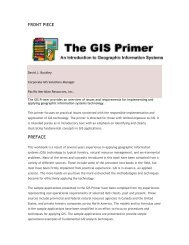Ecosystem Guidelines for Environmental Assessment
Ecosystem Guidelines for Environmental Assessment
Ecosystem Guidelines for Environmental Assessment
You also want an ePaper? Increase the reach of your titles
YUMPU automatically turns print PDFs into web optimized ePapers that Google loves.
SCEPS<br />
2<br />
How much space do spatial components of ecological processes require<br />
The Framework <strong>for</strong> a Conservation Plan <strong>for</strong> the Cape Floristic Region (Cowling et al. 1999) presented a wide<br />
range of spatial components of ecological processes that occur at different scales, and require significantly<br />
different areas of natural habitat <strong>for</strong> their persistence. Some examples are given below (see Table 3).<br />
TABLE 3: SCALES AT WHICH ECOLOGICAL PROCESSES MAY FUNCTION<br />
ECOLOGICAL PROCESS<br />
SPATIAL COMPONENTS (NATURAL HABITAT)<br />
Specialist pollinator relationships<br />
Small (5-1000 ha) fragments<br />
Regular, whole-patch fires<br />
Small (ca 500-1000 ha) fragments<br />
Predator-prey processes involving smaller<br />
to larger predators<br />
Large (50 000-100 000 ha) areas to mega-sized<br />
(250 000-1 000 000 ha) areas<br />
Diversification of plant lineages in relation to macroclimatic<br />
and fine-scale geographical gradients<br />
Large (50 000-100 000 ha) areas<br />
that encompass maximal heterogeneity<br />
Plant herbivore processes involving<br />
megaherbivores<br />
Mega-sized (250 000-1 000 000 ha) areas<br />
Faunal seasonal migration<br />
Areas spanning lowland-upland gradients<br />
Diversification of plant lineages in relation to<br />
lowland-upland gradients<br />
Areas spanning lowland-upland gradients<br />
Resilience to climate change<br />
Large and steep climatic gradients along north-south<br />
and east-west axes in lowland and upland regions<br />
3<br />
Fixed and flexible spatial components of ecological processes<br />
Systematic conservation planning recognises two categories of spatial components of ecological<br />
processes: those that are spatially fixed, and those that are spatially flexible. Both are described below.<br />
SPATIALLY FIXED COMPONENTS OF ECOLOGICAL PROCESSES<br />
Spatially fixed components of ecological processes capture processes associated with clearly defined,<br />
physical features in the landscape. There are no alternative corridors or vegetation boundaries <strong>for</strong><br />
accommodating them, so they are unique and require special attention. An example is plant diversification<br />
along soil interfaces, which can occur at varying scales. The spatial component (the interface) can<br />
consist of a strip just a few metres wide where contrasting soils or rock types meet and where plant<br />
speciation is known to occur. In other situations, the interface can extend over wide areas such as<br />
SPATIAL COMPONENTS OF ECOLOGICAL PROCESSES : 81
















